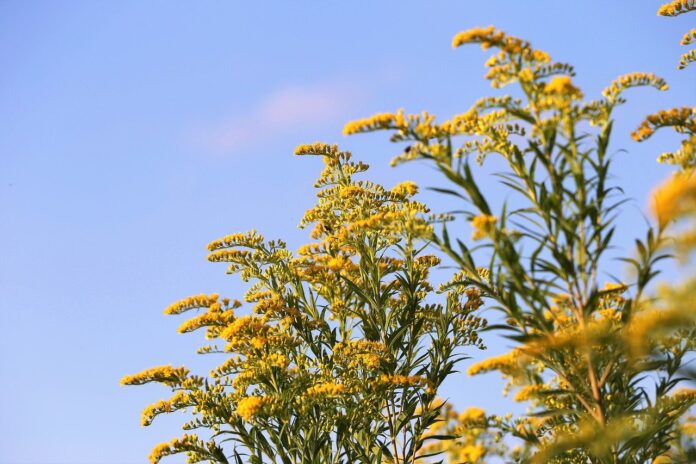Itchy eyes, runny nose, sore throat; all things that those with allergies are familiar with this time of year and we all know what that means: ragweed allergy season is here.
“You mean goldenrod allergies, right?” Goldenrod gets a bad rap, mostly because its bright yellow flowers stand out this time of year when all those annoying symptoms begin. Goldenrod pollen is very dense and usually only falls close to the plant. Meanwhile, ragweed has light pollen that readily gets airborne and can travel long distances on the wind right to your nose.
Looking out at my pastures, I can see the yellow flowers of the goldenrod plants along the wood line and interspersed throughout the fields. I also see that dastardly giant ragweed as well as wingstem, Joe-Pye weed and Ironweed. Using the standard definition, “a weed is a plant out of place,” most agriculturalists would call these plants a weed, but I call them forbs.
Pollinators
Why are they not weeds? I don’t like to use the word weed for these plants because the word weed has a negative connotation to most people and invokes thoughts of a harmful plant that must be destroyed. While I didn’t plant these forbs intentionally in my fields, they are far from being unfavorable to me and my operation.
Goldenrod and wingstem are both very important late-season food sources for bees and many other pollinators. Joe-Pye weed attracts butterflies, bees and is the host plant for caterpillars of several moth species. While not as widely used by pollinators, ironweed still attracts butterflies and ragweed is used by some bees.
The advantage of having plants around to attract pollinators is apparent because their population worldwide has been in sharp decline. Up to 75% of crop species get at least some benefit from pollinators, including increased yields and quality.
Forage
“I don’t raise bees, I raise livestock.” Well, then do I have some news for you! Many of these forbs are actually very high in nutritional value. Giant ragweed has been measured at 22% crude protein and 37% neutral detergent fiber or NDF. Compare that to alfalfa, whose typical crude protein is 18-25% and somewhere near 40% NDF, and you will see they are essentially equal as a forage.
Typically, the taller the plant grows above ground, the deeper its root depth. This means that these plants can “mine” nutrients and minerals from the soil that would be unavailable to the typical pasture plants. When the biomass of forbs decomposes, they deposit these previously unreachable nutrients close to the soil surface where they can be used by the forage grasses and legumes.
From my own observations on my farm, I know that my sheep love to strip the leaves of ironweed especially once it flowers. I have found little to no research on ironweed as a forage, but I assume it may be due to the mineral content or maybe just out of boredom. Goats will readily eat many of the forbs as they are browsers and eat leaves and stems of forbs and woody plants.
Diversify.
“Weeds” are not a problem, but an indicator of an issue with the management of an operation.
Having a diversity of plants in your pasture can be good for your farm — you may just have to diversify your operation. Add other species of livestock to your operation or change up your grazing management.













